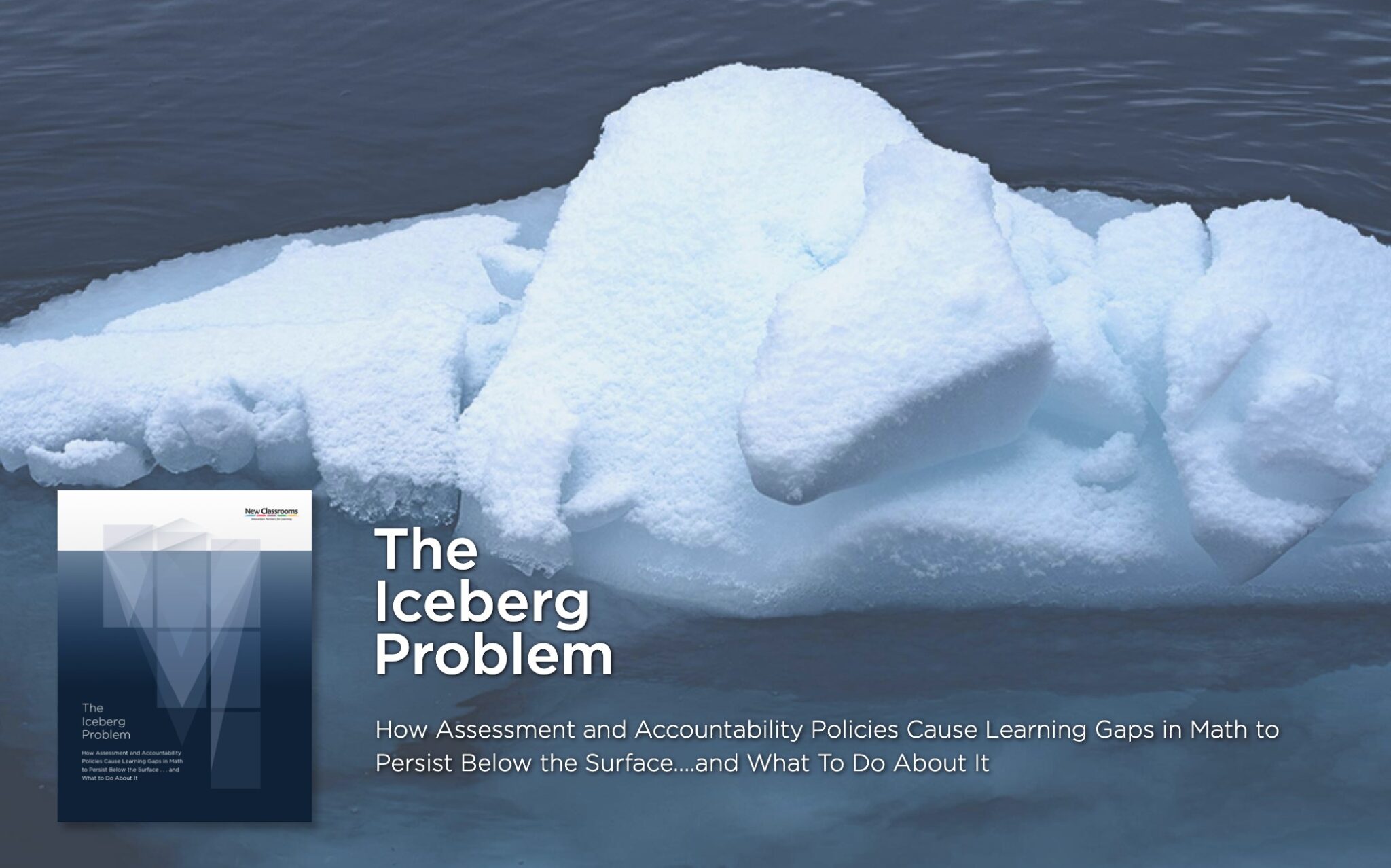Webinar: “Stop Learning Loss in its Tracks” Part 1 with Joel Rose & Travis Larrier
May 14, 2021What should a future-thinking, equitable classroom in the recovery-era look like? How do we assess unfinished learning and provide data-driven instruction? How can teachers tailor the classroom experience to meet the unique needs of each and every student? In part one of our “Stop Learning Loss in its Tracks” webinar with Joel Rose and Travis Larrier, we explore each of these ideas and provide actionable solutions for educators. Watch the recording or read a copy of the webinar below to discover what’s possible. For part two, a conversation with a panel of teachers across the country who are using Teach to One to address their students’ learning gaps, click here.
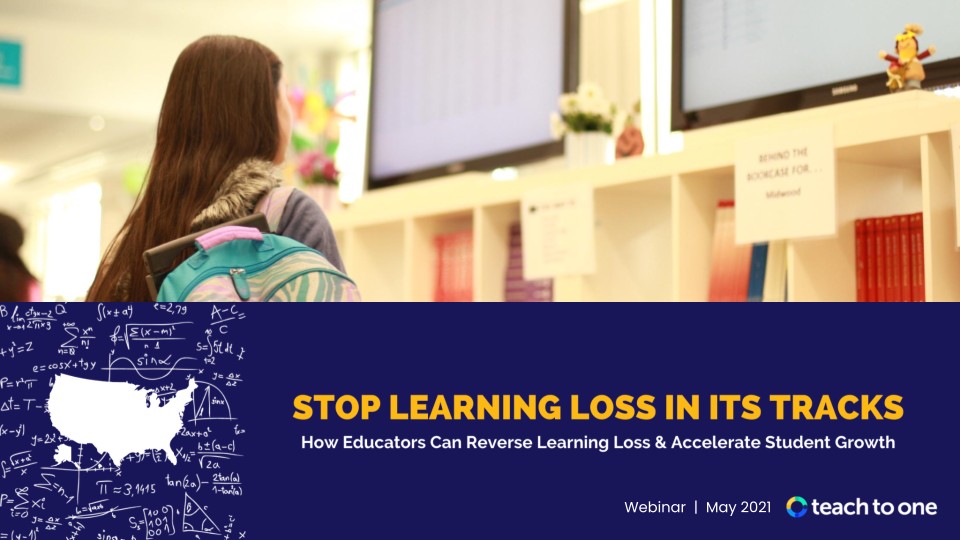
Travis Larrier: For today’s agenda, we’re going to answer, “what should a future thinking equitable classroom in the recovery era look like?” Joel Rose, our co-founder of Teach to One, is going to set the stage by discussing the challenges of the recovery era and how innovation in the classroom can play a critical role. Then we’re hosting a panel with three awesome educators from across the country to speak to the innovation they have brought to their classrooms and what the future looks like. Then we’ll save some time at the end to answer any audience questions.
Travis Larrier: So to start off the webinar we’re joined by Joel Rose CEO of Teach to One. Joel, over to you.
Joel Rose: Thank you, Travis, and welcome, everyone, thank you all for being here. We used to do these all the time live but we are now excited to do this virtually and really engage you all in a new way and share a little bit about what we’ve learned over the last two years when it comes to learning recovery, which hopefully can help you as you think about how to prepare for the future.
Joel Rose: To kick it off, we want to start with research that NWA released earlier this year where they showed that, coming into 2020, students were roughly a year behind where they were otherwise expected to be. And many of us know that a lot of students actually would have otherwise been behind to begin with. So many of us know that learning loss and acceleration, these are not new concepts. It wasn’t like all students were going to show up fully on grade level but for COVID, but certainly this has made this challenge much harder for teachers and it’s really resulted in a lot of states and districts and teachers saying, are there new ways that we could think about addressing this unique challenge?
Joel Rose: So when we think about schools and how schools address learning loss in math in order to support acceleration, it’s important to just pause for a second when we think about math and deconstruct math into the specific concepts that math teachers typically focus on over the course of a school year. So if you look at this chart, what you’ll see is, in a typical classroom all the way on the left in a fourth grade classroom, there are roughly 42 fourth grade skills.

Joel Rose: When I say skill, I mean the procedural, the conceptual, and the applied dimensions. Think of it like a chapter in a textbook: 42 concepts that are covered, typically, in a fourth grade classroom. But to learn those 42 sills, there are 22 predecessors skills. It’s really hard, for example, to learn how to multiply if you haven’t quite mastered addition. So to do well on that fourth grade assessment to master all the fourth grade material, there are really 64 skills, cumulatively, that a student must learn.
Joel Rose: Moving now over to the fifth grade, a student in the fifth grade will learn 40 new skills but those 40 new skills require 30 out of the 42 fourth grade skills and 19 pre fourth grade skills. So there are really cumulatively 89, and this is really how math cascades over time. Math is cumulative. So we know, for example, we want to make sure as many students as possible get through algebra all the way on the other end and there are roughly 52 algebra skills. But in total when we think about all of the algebra-related skills that students should have learned in the eighth grade, the seventh grade, the sixth grade and so forth, it really comes down to 147.
Joel Rose: Now the way math has historically worked is that teachers have been asked to teach what we would say is the “top of the column.” The fourth grade teacher will have a fourth grade textbook, and a scope and sequence that covers the 42 skills. The fifth grade teacher will have the same materials but will have a set that covers the 40 fifth grade skills, so on and so forth. “Top of the column” instruction has been basically the way that schools have been organized for decades.
Joel Rose: What we have learned is that when students come in behind for whatever reason, they end up falling further behind when instruction is focused at the top of the column, when instruction is focused exclusively on grade-level material. That doesn’t mean teachers can’t have high expectations, but it does mean that if a student is walking into a seventh grade class that has the equivalent of a fifth grade understanding and the seventh grade teacher only teaches seventh grade material, that student is going to fall further and further from proficiency and ultimately achieving college and career readiness. This can exacerbate inequities.
Joel Rose: We wrote about this phenomenon extensively before the pandemic in a report we released called The Iceberg Problem, where what we argued was that in many middle school math classes, a student, let’s say a sixth grade student, there will be some sixth grade skills that they learn but there’ll be a set that they don’t learn. The school will focus on their performance level on their state summative assessment, a one, a two, or a three but there is this unfinished learning that’s accumulating below the surface. When the same student gets into seventh grade, there will again be some seventh grade skills they can master but a set that they don’t and that unfinished learning back from sixth grade will now compound to unfinished learning from the seventh grade and then the same thing happens in the eighth grade.
Joel Rose: So while many schools are focused on the performance level based on the state summative assessment, the top of the column, all of this unfinished learning is accumulating. We call this the “iceberg problem” because it’s not generally seen, since this accumulation doesn’t generally show up on state summative assessments. A student can get a one and just missed the cut off, or a student can get a one and be multiple years behind.
Joel Rose: We see this phenomenon in national data as well. So if we look at NAEP data from 2015 fourth graders, we see that 40% were proficient. When that cohort became eighth graders in 2019, 34% were proficient. This pattern of fourth grade outscoring eighth grade four years later is true in 50 out of 50 states. It is not true in reading. In some states, eighth grade scores go up, and in some states they go down, but math is different because math is so cumulative and that’s why we see this particular pattern.
Joel Rose: What we are focused on instead and what we advise states and schools and districts to do is to consider a strategy that is called “tailored acceleration.” Tailored acceleration looks at what every student is starting from, and gives them their own personalized mix of pre-grade, on-grade, and in some cases post-grade skills that get them to proficiency in one, two, or three years. So we are not compromising at all from the objective of getting students to proficiency and college and career readiness but we are giving some students more time to get there in ways that truly reflect where they’re starting from and where they ultimately need to be.
Joel Rose: There are a number of approaches for schools that want to consider tailored acceleration and we have some solutions that can help them. Other organizations have solutions as well but it’s the philosophy of tailored acceleration that we think is the most essential. So for schools that want to understand exactly what schools know, and what each student knows and doesn’t know, relating to getting to proficiency, that’s a diagnostic. Another school may want to use a Mastery Tracker to help track how students are progressing on their own personalized roadmap.
Joel Rose: One more click up, schools may want a digital tool where students can actually accelerate on their own roadmap either at home through a home practice program or as an intervention tool within the school day. That we call Teach to One Roadmaps Plus. Then finally some schools may say, I actually want to reorganize my entire classroom, either as a supplement to my core program or as a core program in order to enable this level of personalization. We call that Teach to One 360 and let’s share with you a little bit about how these particular solutions work.
Joel Rose: Let’s talk first about Roadmaps Free. So Roadmaps Free is a free diagnostic assessment that schools can use, and also families can use, that focuses on the column. It is an adaptive test. So if, for example, a student is in the sixth grade, the adaptive assessment will only focus on the sixth grade column and the algebra column because the algebra column is included with every diagnostic. So it’s eighth algebra in seventh grade, algebra in eighth grade but a student will get precisely the skills they need to master in order to get to the top of the column. In this case, the algebra, the 147 skills that are in the algebra column.
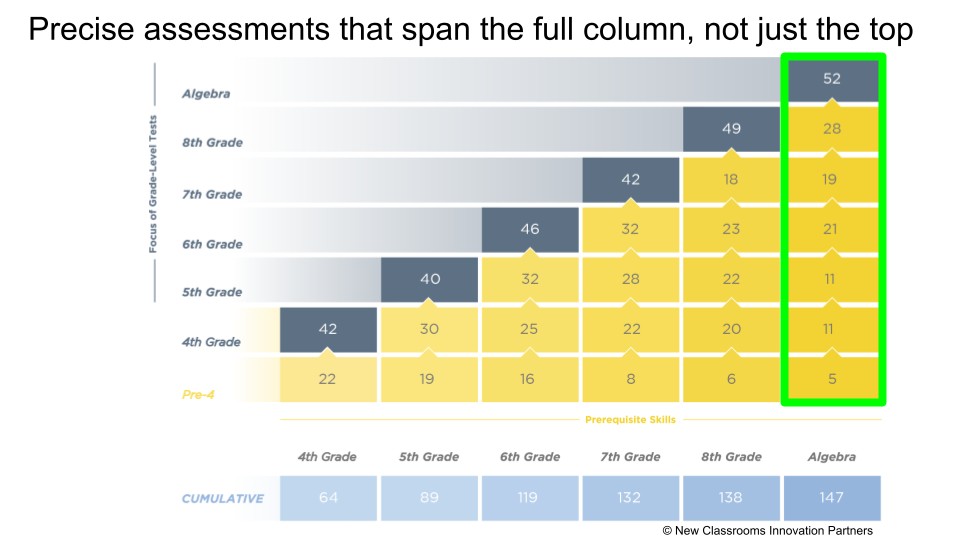
Joel Rose: A student takes a three part diagnostic assessment. Each part is about 30 minutes, and based on that diagnostic assessment, the student sees at first the graphical representation of what they know in that column and what they still need to learn. So the blue reflects what are the algebra related skills the student knows going all the way back to before the fourth grade and the white represents what skills they still need to learn. So, in this case, the student knows every algebra-related skill in sixth, fifth, fourth and before fourth, knows almost all of the seventh grade algebra-related skills and about 40% of the algebra-related eighth grade skills and one or two algebra skills.
Joel Rose: The student can then access precisely those skills, what is included in their roadmap. So in this case the student will need to learn how to solve two-step equations with positive or negative numbers, or equations with variables on both sides. They can see exactly what skills they need to learn, and on the right hand side, you see a way where in this particular case, the student placed out of 79, out of the 147 algebra skills from that column, they still need to learn 68 and that is really what makes up their discreet roadmap and the student can actually check off, the student can check off when they need help with the skill or when they worked on a particular skill and that’s their mastery tracker. That is what Roadmaps Free can do and any school is welcome to try it whenever they like.

Joel Rose: The second solution we have available is called Roadmaps Plus. What Roadmaps Plus does is it builds off of Free, but it adds, for each skill, lessons and short form assessments that allows students to progress on their roadmap. So in this case the student was working on a roadmap with 132 skills. They placed out of 27, they have 105 to go. If I, for example, needed to work on fractions and unit fractions, I could click on lessons and I would be able to get lessons from a variety of providers with aggregated content from School Yourself, Khan Academy, Shepherd Software and there’s an NCTM game there, actually.
Joel Rose: We’ve aggregated content from multiple providers so the student can actually select how he or she likes to learn best. Some kids love Khan Academy, some kids not so much. Some love School Yourself, some not so much. So they pick the lesson that they think will best teach them and then once they think they know it, they take a short form assessment and if they score at least 80% on that assessment, it counts as completed and it then turns to green on their roadmap.
Joel Rose: So you can see in this case a student has been progressing, they finished mastering all the pre-fourth grade skills related to seventh grade and some fifth grade and some sixth grade. So Roadmaps Plus allows students to progress on their roadmap. Some schools use Roadmaps Plus as a homework supplement. They say every student should work 30 minutes a night on their roadmap. Some might use it as an intervention period within the school day.
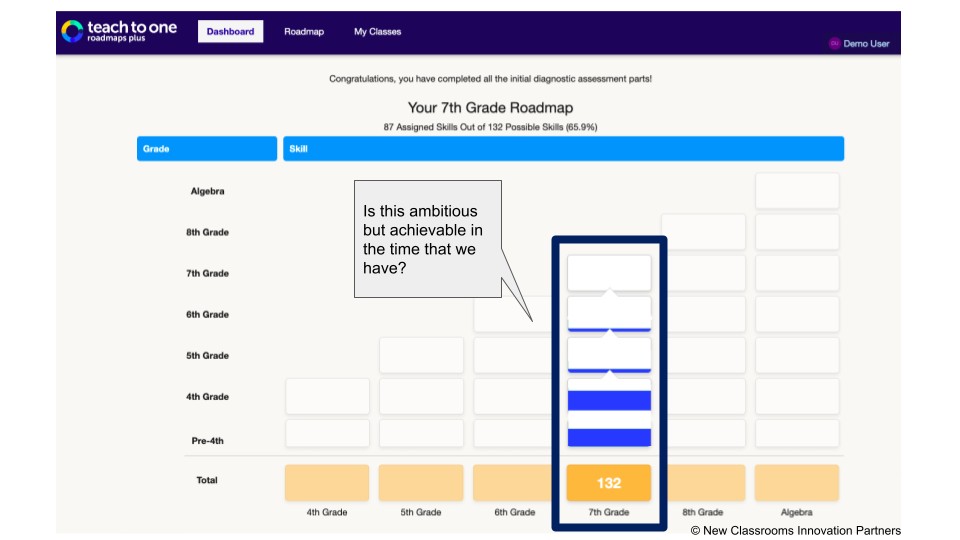
Joel Rose: Another important feature of both Free and Plus is the ability to explore multi-year learning progressions. So you might ask, “why did I share at the beginning that every student gets an algebra roadmap and a grade level roadmap?” Well, here’s why. What some schools may recognize is that if a student, for example, this seventh grade student, takes their initial diagnostic, the school may see, “wow there are a lot of skills that this student needs to learn to get to seventh grade proficiency, and all in a single year.” We can choose to go forward, and maybe we’ll find ways for that student to hit that milestone, but another option is to instead have that student work for multiple years, two years or three years, on the Algebra roadmap as opposed to one year on the seventh grade roadmap.
Joel Rose: So you recall that visual we showed you of the different swoop. Some students are furthest behind, this student might be on a two year plan, or a three year plan where we’re going to de-prioritize any skill that doesn’t specifically relate to algebra and give that child two or three years in order to hit that particular milestone of algebra proficiency. These are choices that educators can make that connect where students are starting from to where they ultimately need to be.
Joel Rose: The final solution we have, and I think the one that our panelists are going to talk the most about, is called Teach to One 360. This is a totally different way of thinking about the classroom itself. So for teachers and schools that say, you know what, we really, I don’t want to just be doing the same “one teacher teaching all 28 of my students the same thing at the same time,” I want to reorganize my classroom in order to enable this level of personalization. This is what 360 does and here’s how it works.
Joel Rose: If you imagine you’re a sixth grader and you have reading first period in room 206 and you have P.E. second period in the gym, third period you have math and instead of walking into room 105, you walk into, what’s typically, but not always, a big open space with lots of different stations. In some stations kids work with teachers, in some stations kids work collaboratively, and in some stations kids work independently. When you walk in for math as a student, you look up and you see a big TV monitor that looks like what you might see at an airport and you see your name and you see which station you’re supposed to go to.
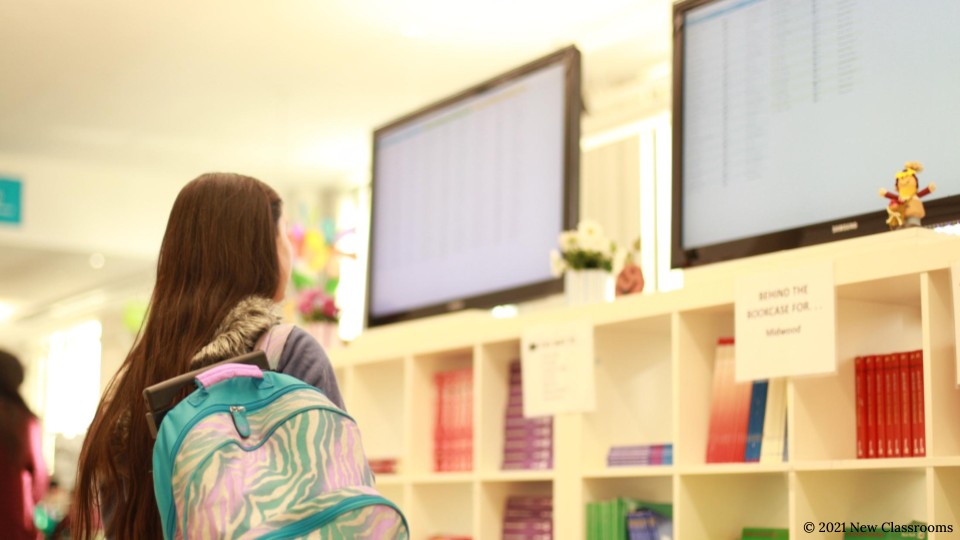
Joel Rose: So you might spend the first 30 minutes working on binomials with a teacher and 17 other students who need to learn binomials at that exact moment in time, and then you might spend the next 30 minutes in a peer-to-peer activity working with binomials and then in the last 10 minutes you take an online assessment in binomials and then you’re off to science class. We then take the data and create a new schedule for you and all of your classmates for tomorrow based on how you did today, and the resulting teacher schedules come out of that as well. So we make thousands of schedules every day that help each student to be in the best position to accelerate based on what they know as of that particular day.
Joel Rose: So that is a little bit of how 360 works. So, to summarize, lots of entry points for tailored acceleration; diagnostic and a mastery tracker with Teach to One Free, a digital solution, which can be done at home, or at school, which we call Teach to One Roadmaps Plus, and then an innovative learning model which is 360 which can be done as a supplement to core instruction or as a replacement for core instruction.
Joel Rose: That is a little bit about how tailored acceleration works and I’m excited to turn it back to Travis and our amazing panel who’s been working with these solutions over the course of the last year and more.
Travis Larrier: Awesome, thanks Joel. Before we go over to the panel, we have some questions in the chat, let me see if I could maybe boil them down to sort of one question before we launch into the panel for you, Joel. So a question that I’m seeing popping up is, “are students ever engaged in doing math physically with manipulative investigation? How do you consider project-based learning?” Just talk about that for a second, and then we’re going to turn things over to the panel.
Joel Rose: Sure. It’s one of the most important questions, and some of the panelists maybe can answer it better than I can, but it is a deeply ingrained part of the program. We have nine different modalities, two of them involve the computer. The rest involve live instruction, independent learning, and collaborative learning. So the collaborative modalities require students to work together as a group to solve problems in a collaborative way, often with manipulatives.
Joel Rose: Also, one of students’ favorite modalities is called Task, which is really more project-based learning, which actually takes up a number of sessions over two weeks where students together work on a project that ends up at the end of each two weeks with something called a Task Demonstration, where students share their thinking and they’re judged not only by their teacher but by other students that are in their task group. So we think that type of learning, project-based learning and collaborative learning, is really essential to building the sort of deep conceptual understanding and frankly a love of math that is so essential for students while they’re in school.
Travis Larrier: Awesome, thank you so much, Joel.
